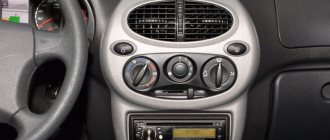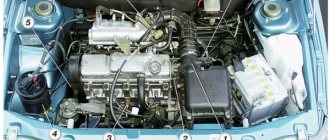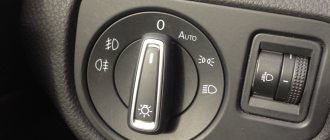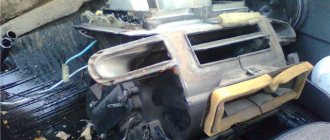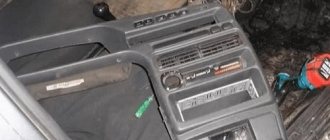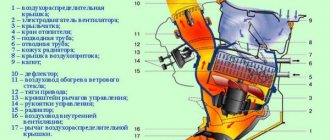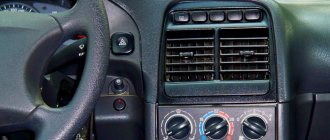With the arrival of cold weather, some drivers are puzzled by finding the reasons why the heater in the car does not heat well. Moreover, sometimes the stove in the car begins to work so poorly that it becomes absolutely unable to warm the interior. In addition, in severe frost the situation is further aggravated by glass freezing. What to do in such cases?
In fact, there are not many reasons why the heater in a car may not work efficiently, and below we will look at each of them.
At the end of this article, watch a video with a detailed description of the reasons why stoves in cars do not work well and how to eliminate them.
In the meantime, you are figuring out the reasons why the stove is not heating well, we recommend that you pay attention to alternative methods of heating the car interior:
- How to choose a car interior heater from the cigarette lighter;
- How to choose a heated car seat cover.
Of course, these “warmers” will not replace the standard stove in the car, but they will undoubtedly add comfort even after it has been repaired.
What to do if the stove in the car does not heat well
If the stove in the car does not heat well or does not work at all, then you first need to determine the cause of the malfunction and then eliminate it. Most problems with a car heater manifest themselves as follows:
- The stove in the car does not heat well;
- The heater in the car blows cold air;
- The stove in the car sometimes works, sometimes it doesn’t (it blows either cold or hot air);
- The air from the stove in the car is quite hot, but it blows weakly;
- The heater in the car does not work (does not turn on).
In the table below, we have combined the possible reasons for the malfunction of the car's interior heating system, described how they can affect the operation of the stove, and listed ways to eliminate them.
| Possible cause of stove malfunction | Symptoms of a malfunction | Remedies |
| Air in the interior heating and engine cooling system | 1. The stove does not heat well; 2. The stove blows cold air; 3. The stove blows either cold or hot air. | 1. Remove air from the system (simple method here); 2. If air is not removed or appears again, check whether the cylinder head gasket is broken. |
| Thermostat stuck open | Check the thermostat, if a malfunction is detected, replace it with a new one. | |
| Heater radiator clogged | 1. The stove does not heat well; 2. The stove blows cold air. | 1. Vacuum the surface of the radiator; 2. Flush the engine cooling system; 3. If all else fails, replace the radiator. |
| Problems with the heater valve or air damper controls | 1. Check whether the cable has come off the damper control levers or the heater tap; 2. If the heater tap is faulty, it must be replaced. | |
| Cabin filter clogged | 1. The air from the stove is quite hot, but it blows weakly. | Replace the cabin filter. |
| The fan is not blowing well | Contact a specialist (auto electrician) to determine the causes of the malfunction and eliminate them. | |
| The fan does not turn on | 1. The stove in the car does not work (does not turn on); 2. The air from the stove is quite hot, but it blows weakly and only at high speed. | |
| Problems with the stove control unit | 1. The stove does not heat well; 2. The stove blows cold air; 3. The stove blows either cold or hot air; 4. The stove does not work (does not turn on). |
Airlock
The problem is due to a faulty conservator cap and insufficient coolant level. Factors affect the cooling system, in which excess air accumulates, creating an air lock. Due to insufficient circulation at low speeds, the stove blows cold. The air heats up when the speed increases, and when stopped it cools down again. What to do? Eliminate the root cause: as in the case of system depressurization, add antifreeze, replace the expansion tank cap, bleed the system, blowing out excess air. You can remove the air by standing on an overpass so that the front wheels are higher than the rear wheels. Open the expander cover. At this moment, the air will come out accompanied by a characteristic sound (“gurgling”). Coolant will also leak, so it is important to top it up to the required level. After this procedure, it is likely that after a while the air lock will form again. This is due to a blown cylinder head gasket. But in this case, the stove does not work well not only at idle.
Related article: Do I need to warm up the engine before driving?
Preventing the operation of the stove in the car
In order for the stove in your car to heat well and not let you down at the most inopportune moment, you need to follow a few simple tips.
- Keep the radiator clean. Light contamination from the outside of the radiator can be removed with a vacuum cleaner. Flushing the engine cooling system, with which the heater radiator is inextricably linked, will help get rid of internal deposits and blockages in the channels.
- Use good antifreeze . High-quality antifreeze is the key to long-term operation of not only the stove in the car, but also the engine. Remember this and do not forget to replace it in a timely manner.
- Change the cabin filter more often . A clogged cabin filter will certainly create problems not only for the operation of the stove, but also for the air conditioning and cabin ventilation system as a whole. In addition, dust and pollen deposited in the filter can pose a serious health hazard (especially for allergy sufferers).
If, at an outside temperature of minus 25 °C, your car’s heater heats the interior to +16 °C from below and up to +10 °C from above, then it can be considered quite serviceable. To avoid problems, it is recommended to carry out preventive measures in a timely and responsible manner that will allow you to enjoy a comfortable ride in a well-warmed-up car.
And remember, the longer the service life of the machine, the more attention its heating system requires. This applies to all cars, regardless of country and manufacturer.
Clogged radiator
Over time, scale forms in the radiator, which creates plugs. The obstruction of the lines leads to a decrease in the pressure that supplies warm air. At high speeds there may be an increase, but at idle you won’t get any warmth. What to do? Theoretically, you can try flushing the radiator yourself. Many auto stores offer special mixtures that destroy salt compounds. But purging and flushing will only work if the lines are not completely clogged. If there is no circulation in one of the pipes, then it will not be possible to flush it. Replacement only. Advice may also include checking the thermostat, replacing the filter (if available), and the gasket. But in practice, the stove does not heat up at idle in 90% of cases precisely because of the high wear of the radiator . To avoid such problems, it is recommended to take preventive measures in time. Use a high-quality cooling mixture, change it regularly, monitor the quality (after draining, for any impurities), do not mix several models of antifreeze. Operate your car competently and enjoy a warm car in winter.
Share with friends on social networks:
Telegram
Thermostat malfunction
e46zone.com
This is a common cause of furnace problems. If the thermostat sticks in the closed position, then the breakdown is noticed immediately, since in this case the engine overheats. But if we are talking about an open or slightly open position, then, as a rule, drivers find out about this only with the onset of cold weather.
If the thermostat is constantly open, the coolant always moves in a large circle. As a result, the engine takes a very long time to warm up, and sometimes does not warm up completely. Of course, there can be no question of any normal operation of the heater. This increases fuel consumption, and in the case of an automatic transmission, its warm-up time also slows down.
Signs of a faulty thermostat are more or less tolerable heating of the stove when driving at low speeds and cold air from the ventilation when driving on the highway. The fact that the thermostat is constantly open is indicated by the simultaneous heating of both radiator hoses. Normally, when starting the engine, one of them should be warm and the other should be cold.
What to do
There is only one option: replace the thermostat with a new one.
How to understand that the stove is not working properly
If, in 25-degree frost, the car interior warms up to 16 degrees at the feet, and up to 10 degrees under the ceiling, then the heating system is working properly. The car needs an average of 15-20 minutes for the liquid to warm up to the required temperature and begin to heat the car interior.
The heat from the stove (unless it is an autonomous Webasto) does not immediately warm the interior after starting the engine. The liquid is also frozen and needs time to warm up. For example, the optimal engine warm-up time in winter is approximately 5-10 minutes. The engine will warm up the antifreeze from minus to about 60 degrees. Afterwards, heat will flow from the nozzles of the heating system. Therefore, experienced drivers do not immediately turn on the heater, but after a few minutes.
But it happens that even after 20 minutes the heater in the car’s interior does not heat up and cold air comes out. What's wrong?
Heater housing leakage and radiator displacement
subaruoutback.org
A fairly rare problem is a violation of the seal of the housing. After an accident or improper assembly, the plastic parts of the stove may be damaged or have gaps through which hot air will escape. In this case, the efficiency of the heater will decrease significantly.
In some cars, due to weak latches or other design flaws, the radiator may move out of its place, and the air pumped by the fan will not pass through it, but past it. The same thing happens when the air duct damper is closed, that is, there is no heat to speak of.
What to do
In both cases, it is necessary to disassemble the dashboard in order to get to the heater and restore its normal operation. That is, correct the damage, seal the joints of the body parts, return the heater radiator to its place and secure it well.
You can handle this on your own, but the work is not easy. Therefore, if you are not confident in your abilities, contact specialists.
Damper servo drive failure
drive2.ru
Another reason why the stove heats up, but the heat does not reach the interior, is a malfunction of the damper. In all modern cars, the heater radiator heats up constantly, and heat comes from it only when the air duct damper is open. If the damper does not open or does not open completely, there can be no talk of an optimal temperature.
The damper is driven by a servomotor, which is controlled by a knob or buttons on the climate control panel. The problem can be either a breakdown of the servo drive itself or slipping of the cables or rods that drive the damper.
What to do
This problem can only be identified and corrected by disassembling the heater panel. If rods or cables have come off, they need to be returned to their place. A servo drive malfunction, unless it has completely failed, can only be diagnosed by a specialist. Servo drives rarely need to be repaired; the problem is usually solved by replacing them with a new one.
The engine does not warm up, the thermostat is stuck
The cabin heater uses the heat generated by the engine. As soon as it heats up, warm air begins to flow into the cabin. If the interior does not warm up when the heater is on, then the engine does not reach operating temperature . And a stuck thermostat is usually to blame for this .
This is a valve that regulates the circulation of antifreeze through the cooling system in a large and small circle. If the thermostat is stuck opening, the coolant will circulate only in a large circle, through the radiator, where it is constantly cooled - and the engine does not heat up (the circulation of antifreeze in a small circle is responsible for this), and the stove “does not blow.”
If 3-5 minutes pass when starting the engine, and no warm air comes from the cabin heater, this is a reason to check the operation of the thermostat and, if necessary, replace it.
The stove may also work inefficiently due to the design features of the motor itself .
Diesel internal combustion engines, turbocharged gasoline units and modern small-volume (up to 1.4 l) economical units take a very long time to warm up precisely because of their high energy efficiency. That is, at idle, such motors produce less heat than the stove needs for normal heating.
Insulating the engine compartment or installing a pre-heater will help solve this problem.
Climate control doesn't heat well
There are also some nuances to heating in cars with climate control. The heating turns on automatically when the temperature drops below the limit set by the regulator. When the interior temperature is warmer than the set temperature, the system will not turn on. In this case, you can check the serviceability of the system with a warm engine by turning the regulator to maximum.
Sometimes there is a subjective feeling that the stove is not working well. For example, if yesterday it was + 5 °C outside, and today it is 20 °C, and the engine has not yet warmed up.
Almost all motorists are faced with the problem of their feet freezing in the car. Moreover, what’s surprising is that your feet get cold, both in domestic cars and in foreign cars (of course, not all, but still). What to do with this scourge? Let's figure it out.
